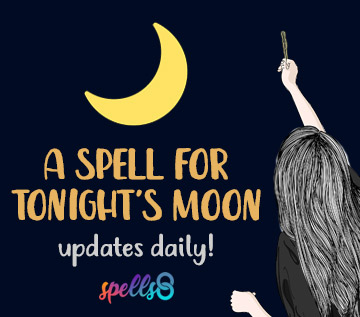In the velvet expanse of the night, the silver-crowned goddess Luna guides her chariot across the indigo canvas of the darkened sky, drawn by oxen with eyes like polished onyx. Luna stands tall, her gown trailing behind her in a cascade of midnight silk. Her silver hair unfurls as she rides like a comet’s tail trailing behind her.
Who is The Goddess Luna?

With beautiful wings, horns resembling that of a bull, and a golden crown placed gingerly upon her head, the Roman goddess Luna is the personification of the moon herself. While it is difficult to find information on Luna, she is often syncretized with the Greek goddess Selene, who shares many of her attributes and mythology.
Luna, conceived from the divine union of Hyperion and Theia, stands out as a radiant goddess with unmatched ethereal beauty. Hyperion, the titan associated with light, and Theia, the Titaness of sight, imbue Luna with her luminous essence and mystical presence.
Luna is the sister of the sun god Sol and Aurora, the goddess of dawn. In some versions of her myths, she rides side-saddle upon her black horse, while her brother Sol rides beside her upon his horse of white. While Sol dances around the Earth, shining daylight wherever he goes, Luna occasionally rides alongside him, allowing us to see our gorgeous moon even in the daytime.

Working with Goddess Luna
The Roman and Greek goddesses associated with the moon were believed to be part of a triadic grouping. Luna, the goddess of the full moon (Greek counterpart Selene), was paired with Diana, the goddess of the half-moon (Greek Artemis), and Hecate, the goddess of the dark moon, residing in the underworld.
See also: The Triple Goddess 🌒🌕🌘
- Mythology
- Symbols of Luna
- Titles and Epithets of Luna
- Signs of Luna
- How to Worship Luna as a Goddess
- Further reading
Myths of Luna
Connecting with the goddess Luna will come as second nature once you know her mythology, epithets, and symbols. Perhaps the most famous tale of Luna is that of her love story with the shepherd Endymion.
Luna and Endymion
In the epic tale of Hesiod’s Theogony, we meet Endymion, a shepherd and astronomer so breathtakingly beautiful that even mighty Jupiter felt a twinge of envy. Worried that Endymion’s radiance would captivate his own wife Luna, Jupiter formed a plan.
Offering Endymion anything his heart desired, the shepherd yearned above all else for everlasting youth. And so it was granted to him. But alas, we soon learn that bargaining with the gods always comes with a cost. Along with eternal youth, Jupiter cursed Endymion with an eternal slumber, a constant state of dreaming without end.

Despite her husband’s relentless efforts to keep them apart, Luna was overcome with an intense passion for the young shepherd’s beauty. Night after night, she descended to visit him, showering his slumbering face with her adoring light. Their forbidden love gave rise to 50 daughters – the 50 Menae, or lunar months.
The First Cults of Luna
It is widely believed that the cult of Luna originates in the legendary tale of Romulus and Remus. During the early days of Rome, with its turbulent history under seven kings, the city came to a crucial turning point.
The eventual overthrow of Tarquinius Superbus marked the beginning of the Roman Republic in 509 BC. In the aftermath of the ancient conflict between Rome and the Sabines, Romulus and Titus Tatius formed a sacred pact to establish a cohesive society, each dedicating themselves to religious worship by establishing various cults. Among them, Romulus revered Jupiter, while Titus Tatius introduced cults dedicated to celestial beings like Sol and Luna.

Luna & The Afterlife
Ancient Roman superstitions held strong, as many mortals believed that spirits were living on the moon. After the rise of neo-platonism, however, this theory expanded to suggest that purified souls rose to the moon after death.
Knowing how lovingly Luna looks down upon us as we sleep, it’s a comforting thought that we might go to her to be embraced in our final slumber.
Symbols of Luna
Symbols of the goddess Luna are unfortunately few and far between, as her worship was never widely practiced, even in the glory days of Rome.
The Crescent Moon: In some depictions, the horns upon Luna’s dainty head resemble the shape of a crescent moon turned on its side, but this isn’t the only reason Luna is associated with this particular moon phase. When worshiped in triplicate with Diana and Hecate, Luna is thought to represent the crescent moon phase, while Diana is associated with the full moon and Hecate with the dark moon.

The Chariot: Luna travels the night sky in a chariot drawn by oxen or horses. This two-yoke chariot, called a biga, symbolizes her journey across the heavens.

Torches: They represent the goddess’s ability to illuminate the darkness and guide the way through the night with her celestial light.

Moonstones: With their ethereal, shimmering appearance, symbolize Luna’s connection to the emotional and mystical, enhancing spiritual insight and harmony with the lunar cycle.

Titles and Epithets of Luna
Here’s a short list of the titles and names of Luna:
- Goddess of the Night Sky
- Noctiluna (Night-Shiner)
- Siderum Regina Bicornis (Two-horned Queen of the Stars)
Download the Printable
This PDF version comes with a transparent background so you can print it on any kind of paper you want and add it to your own Book of Shadows. Find more free printable grimoire pages browsing Spells8.
Signs that Luna is Calling You
Luna is a profound and reflective Goddess. Recognizing signs that she is reaching out can be subtle, so it’s important to be open and receptive.
- Prepare a sacred space dedicated to Luna. Decorate it with moon symbols such as crescent ornaments, moonstones, and silver.
- Light some white candles that reflect the moonlight and remain vigilant for any signs of her presence, such as a sudden insight, a peaceful whisper, or visions during meditation or dreams.
- Engage in nightly moon spells, chant lunar prayers, and immerse yourself in activities that resonate with Luna’s essence, such as night walks, stargazing, or writing poetry inspired by the moon.
- Consider crafting an offering that symbolizes the night, such as a small lunar landscape or a silver piece, remembering that Luna is the Guardian of the night and all its mysteries.
See examples of working with Brigid in the Infinite Roots Coven:
- Moon Worship: The Mother of Universal Protection
- Luna Mother, hear me out
- Selene- My Favourite Goddess
- For the Love of the Moon: A Selene Night Ritual
- Lunar Magic – Moonrise and Moonset
How to Worship Luna
As the goddess of the moon and the protector of the night, Luna is especially revered during the phases of the Full Moon and New Moon. As these lunar events approach, it’s important to engage with the themes of reflection and transition that Luna represents.

Begin by creating a tranquil environment—cleanse your space with sage or other incense, and arrange items that symbolize the moon and nighttime, such as moonstones, silver decorations, and images of the lunar landscape. This setting not only honors Luna but also aids in internal reflection, fostering a deeper connection with the intuitive and emotional aspects of your being.
Below are correspondences that are commonly associated with the divine goddess Luna.
Luna Correspondences
Associations: Femininity, intuition, childbirth, weather, agriculture. She is a patroness to women and farmers alike.
Symbols: Chariot, Crescent moon
Animals: Owl, Oxen, Horse
Gems: Amethyst, Angelite, Moonstone, Pearl, Quartz
Colors: Silver, black, white
Genealogy: Daughter of the titans Hyperion and Theia. Sister to Sol and Aurora.
See also: Moon Herbs and When to Use Their Lunar Powers
Luna Offerings
One way to work with Luna as a Wiccan or neopagan is to craft an altar for her. Include her symbols or a depiction of Luna (such as a statue or an illustration) as well as a place to leave offerings to her.
- Apples
- Cakes
- Dandelions
- Garlic
- Moonstone
- Ripened fruits
Other offerings popular with Greek deities are bay leaves, fruits, flowers, incense, libations of wine and milk, and honey.
Incense for Luna: Dragon’s Blood, Moonwort, Mugwort, Myrrh
Invocations and Prayers to Luna
Luna Ritual
A simple chant to invoke Luna, goddess of the moon and night sky:
“Oh, Luna, silver-crowned and veiled in night,
Your crescent smile graces the celestial dance.
From shadowed boughs, I invoke your ancient might,
Blessed by your rays, I step into your trance.
In your lunar cradle, secrets unfurl—
The ebb and flow of tides, the pulse of dreams.
You weave enchantments with your silver pearl,
Guiding seekers through astral realms and streams.
Your phases mirror life’s cyclical sway,
Waxing hope, waning release, and rebirth.
In your luminous gaze, I find my way,
As spells are whispered upon the sacred earth.
So, Luna, goddess of the moon’s embrace,
Illuminate our path, our magic, our grace.”
Selene’s Chant for Courage
Just like Luna is worshiped in Roman mythology, Selene is the personification of the Moon in Greek mythology.
Chant this prayer to Selene to invoke courage, confidence, remove fear and embrace her bravery in your spirit.
Worshiping Luna is much easier once you better understand her mythology. Spend time creating an altar for her, crafting art in her honor, or even praying to her. Communicate with her through tarot or other forms of divination. Leave her offerings to show that you wish to devote yourself to her. The rest will come naturally. Blessed be.








